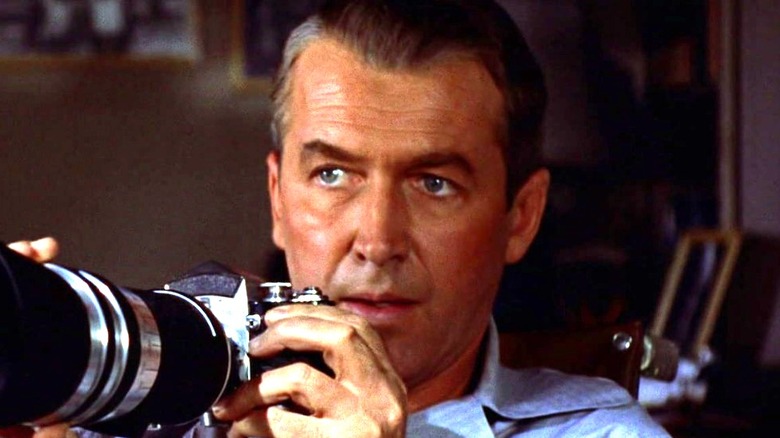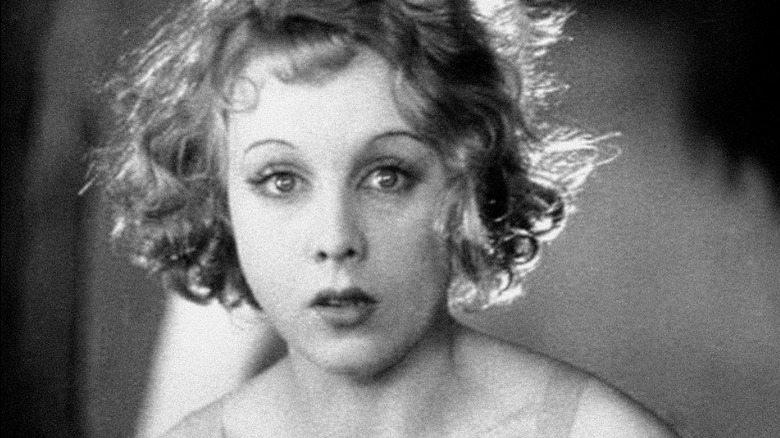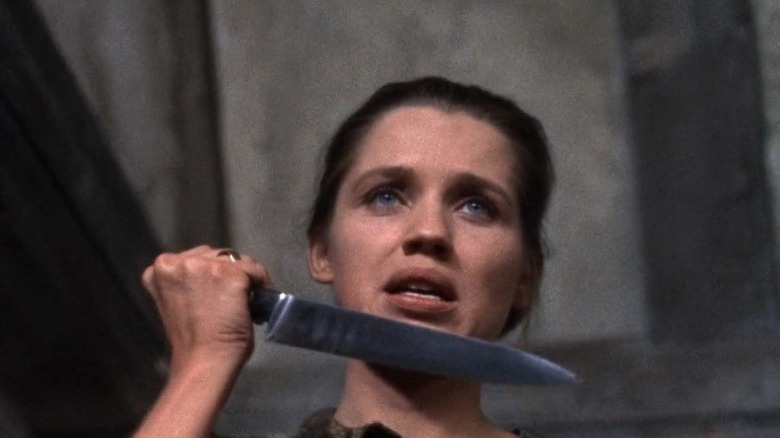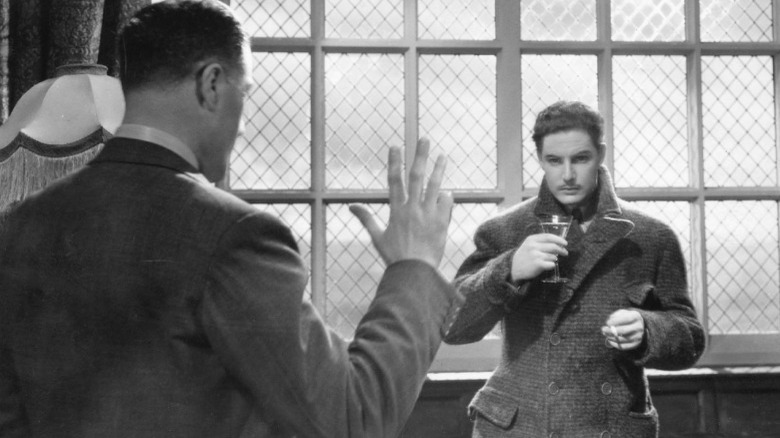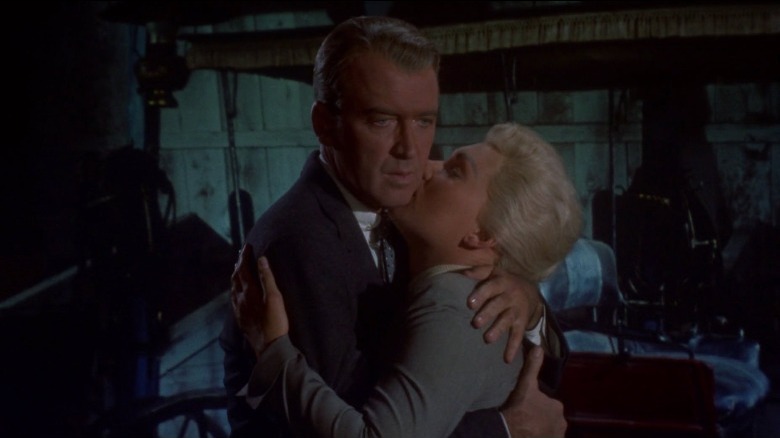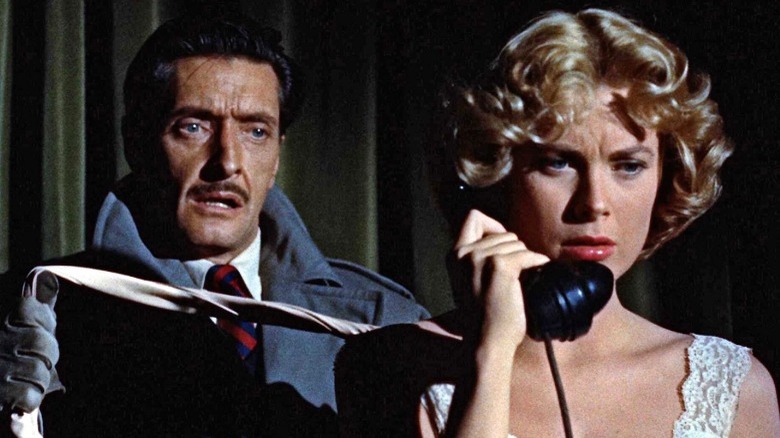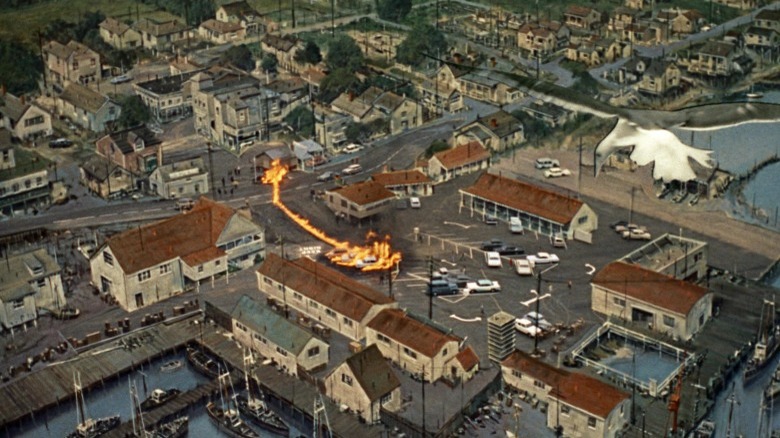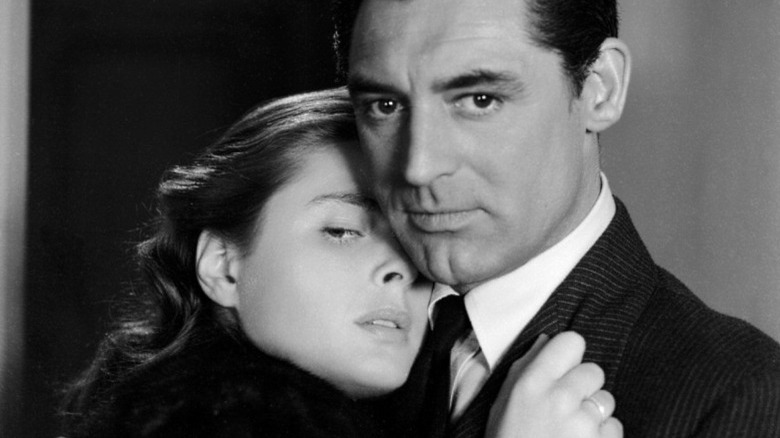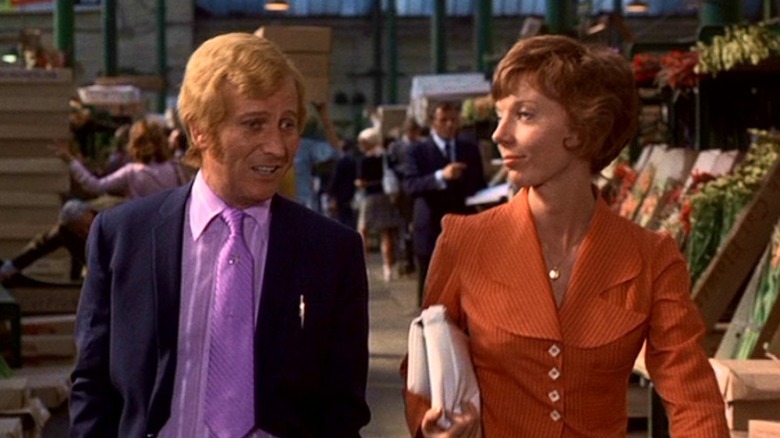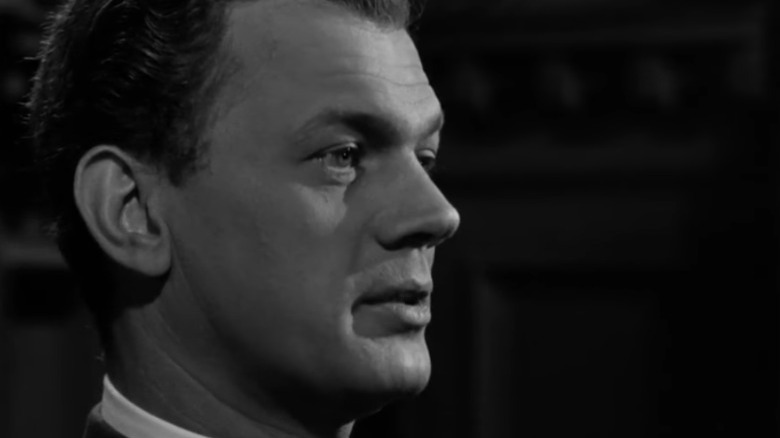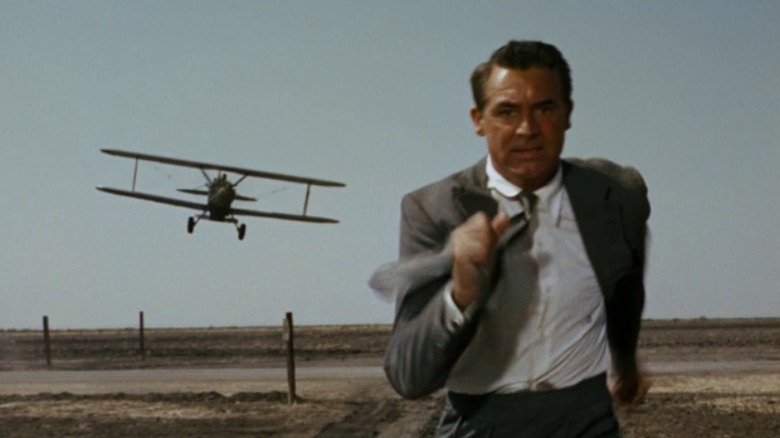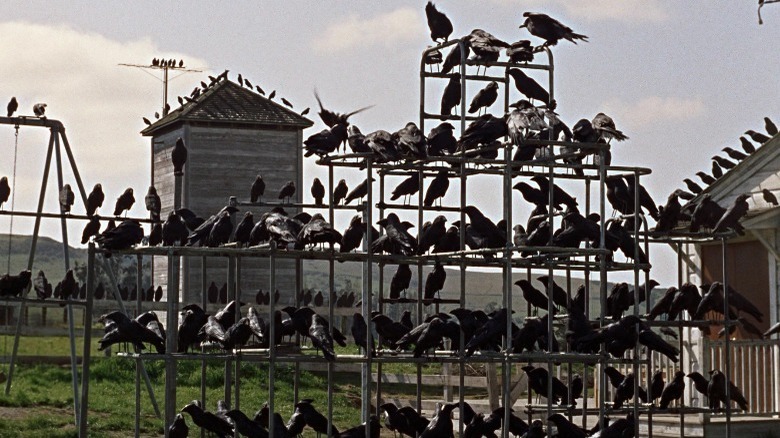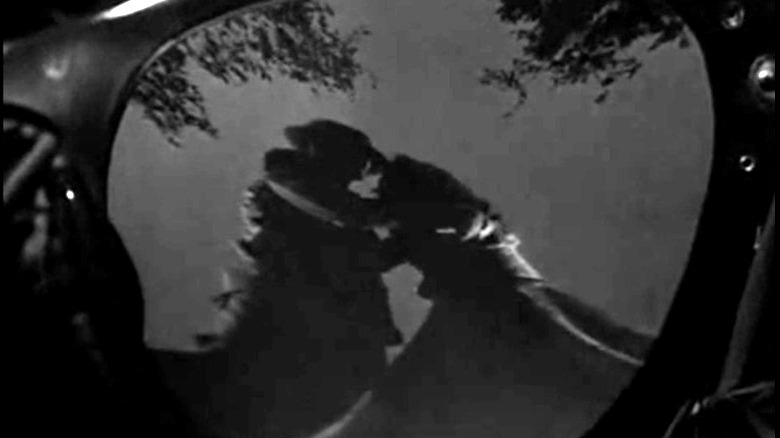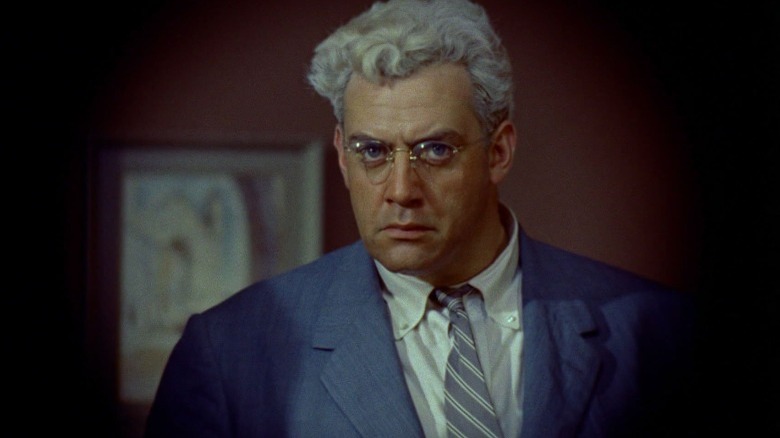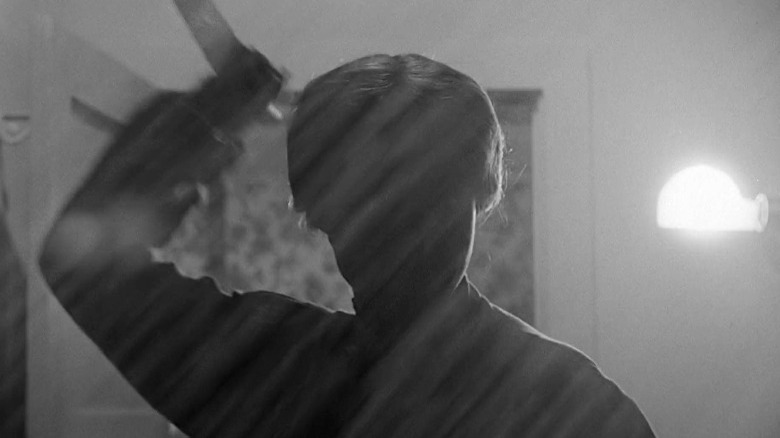The 14 Most Iconic Alfred Hitchcock Scenes Of All Time
It's impossible to overstate the impact Alfred Hitchcock has made on film. His movies have influenced countless other directors, while the tropes he helped create have now entered the film lexicon and shaped the modern thriller. "MacGuffins" — a word Hitchcock created to describe an item that drives the story, but isn't actually all that interesting in and of itself — wrongly accused heroes, and meticulously constructed set-pieces that go off (and go wrong) with clockwork precision are all considered staples of the genre with which Hitchcock has name became synonymous.
No other filmmaker has ever been able to generate tension with such ease, so to celebrate the Master of Suspense, we've compiled a list of his most iconic scenes. Some are long, complicated set pieces and some only last a few seconds, but all make an impact on viewers, sending shivers down their collective spines, and helped redefine the language of cinema.
Knife! — Blackmail (1929)
Hitchcock was always an innovator, and nowhere is this more evident than in his first sound feature, "Blackmail." After suffering an assault and inadvertently stabbing her assailant to death, Alice (Annie Ondra) is in shock. The morning after, she sits at the breakfast table while people around her engage in a mundane conversation. Hitchcock holds on Ondra's increasingly traumatized face as the dialogue slowly fades out, until only the word "knife" is audible.
Hitchcock amplifies the word every time it sounds, and Alice winces with each repetition. The camera cuts closer to her face until she snaps, nearly cutting her father with a bread knife. In a lot of ways, "Blackmail" is a rudimentary film, essentially serving as a first draft for Hitchcock's subsequent, more polished thrillers. This moment still retains its power, though, demonstrating that Hitchcock could constantly adapt with the times, and would use any means at his disposal to tell the story as efficiently as possible.
Murder is not easy — Torn Curtain (1966)
One of Hitchcock's later and, in truth, less successful films, "Torn Curtain" nonetheless features one incredible sequence. Paul Newman plays Michael Armstrong, a physicist moonlighting as a spy in East Berlin who's followed by Gromek (Wolfgang Kieling), a grim secret service agent. When Gromek proves more resourceful than he initially appears (having tailed Armstrong to his clandestine meeting at a farmhouse), Armstrong and his contact, an unnamed farmer's wife (Carolyn Conwell), are forced to kill him.
They find that murder is not easy. Hitchcock reportedly wanted to show just how difficult it is to kill someone and how long it can take. As they struggle, the farmer's wife stabs Gromek in the neck, but the knife snaps off, so she beats him with a shovel to no effect. Eventually, Armstrong and the woman drag Gromek to the oven, where they suffocate him. It's a torturous, protracted scene, and it takes Gromek an agonizing 40 seconds to expire.
The reason why this scene still endures today is the discomfort it provokes in the viewer. Kieling makes his villain all-too likeable, and it's unnerving to watch him being murdered in cold blood. At the same time, Hitchcock makes it increasingly clear to the audience that Gromek must die, removing every other option and making us feel like an accessory to his murder.
Which finger? —The 39 Steps (1935)
The template for every "wrong man" story that followed, "The 39 Steps" remains Hitchcock's most successful early film thanks to a witty script, Robert Donat's winning performance, and some quintessentially Hitchcockian moments. The most unnerving of these comes when Richard Hannay (Donat) finally reaches the supposed contact of the spy who died in his apartment. Moments before her death, she tells Hannay about the agent chasing her and his one distinctive feature: the missing finger on his right hand.
When Hanay meets the professor, he tells the man this, only for the professor to lift his hand with the words, "Are you sure it isn't ... this one?" It's a sobering, impactful moment in what had been, up until this point, a relatively light film, and shows just how doomed Hannay is. It's a scene that only takes a few seconds, but you can feel time just stop; the audio drops out, and we see Donat's face frozen in fear. It allows the viewer to take in the significance of the reveal without hitting them over the head with it.
Judy becomes Madeleine — Vertigo (1958)
Whatever qualms you may have about "Vertigo," it remains Hitchcock's most beautifully-made film. Though overwrought and convoluted, it succeeds as a metaphor for cinema itself. In this scene, Scotty (James Stewart) takes on the role of a film director, demanding that Judy (Kim Novak) change her appearance to resemble the now deceased Madeleine (also Novak). With Judy essentially cast as a Hollywood actress, she is compelled to fit the role that Scotty demands of her.
It's uncomfortable viewing, as Scotty's irritable disappointment that Judy's hair isn't exactly right changes to a look of nervous anticipation as he waits for her return, his expression veering from excitement to dread. When Judy finally emerges, she is bathed in green light, the woman of Scotty's dreams. They embrace in an incredible 360-degree shot; the music swells, and the background shifts to the location where Madeleine fell to her death. This confirms what the audience already knows: Scotty is deeply traumatized, and still obsessed with the woman he failed to protect. It's the most beautiful and technically impressive sequence in a film that often veers into melodrama.
The murder attempt — Dial M for Murder (1954)
Based on a play, "Dial M for Murder" should be a relatively stagey affair, but thanks to Hitchcock's direction and its perfectly judged performances, it still feels cinematic. The attempted murder of Margot (Grace Kelly) by the unwilling Swann (Anthony Dawson) is the centerpiece of the film, but what makes this scene interesting is that it really shouldn't be that suspenseful. Tony (Ray Milland) has already painstakingly laid out his plan for the audience; the beauty is in how Hitchcock puts us on the back foot immediately as things don't proceed like they should.
It's a deceptively complicated sequence, beautifully lit by candlelight as Swann appears behind Margot, slowly raising the stocking to strangle her. The anticipation is what makes this moment so effective. Swann momentarily hesitates — he doesn't want to do this. Then, when he finally attacks, Hitchcock makes sure the scissors are very prominent. Margot desperately reaches for the scissors as she struggles, grabs them, and plunges them into Swann's back. He recoils and spasms before falling directly onto his back, pushing the scissors further in. The shot of Swann landing on the scissors is one of the nastiest and most enduring images of Hitchcock's films, and sears itself into your memory.
The diner scene — The Birds (1963)
A scene from "The Birds" that could easily have been adapted into an episode of "Alfred Hitchcock Presents," this moment initially serves as a brief respite from the film's oppressive tension. Despite numerous bird attacks, the townsfolk of Bodega Bay, or at least the microcosm of the town we encounter in the diner, still don't believe what is happening. These characters only appear in this one scene, but they all feel like real people.
The discussion surrounding the birds is lighthearted enough to lull the audience into a sense of security, and then a lone seagull attacks, indirectly causing an explosion at the gas station. In the middle of this chaos, Hitchcock cuts to a peaceful wide shot from high above, far away from the fire and screaming below, until slowly but surely the birds appear. By today's standards, the effects aren't great, but the way that Hitchcock frames this image is so unnerving that it hardly matters. This one shot of the birds looking down at their potential victims is chilling, and gives the animals agency without detracting from the ambiguity surrounding their attacks.
The wine cellar — Notorious (1946)
Francois Truffaut's favorite Hitchcock film, "Notorious" is a heady mix of romance, film noir, and espionage. It's one of his most successful early Hollywood films, mainly due to the simplicity of the plot, which is essentially a love triangle between Cary Grant, Ingrid Bergman, and sympathetic villain Claude Rains.
It also provides an early example of the MacGuffin, a plot device that is incredibly important to the characters in the film, but of no interest to the audience. "Notorious" is interesting in that there are actually two MacGuffins (a bottle and a key to the wine cellar). This sequence begins with a virtuoso shot of a dinner party, beginning high above the gathering before gracefully panning down and zooming into an extreme close up of Bergman's hand, where we see her clutching the key. It's a stunning shot, and brilliantly conveys the sense of paranoia that pervades the film.
Once Grant and Bergman discover the plutonium-filled wine bottles in the cellar, they are almost immediately disturbed by Rains, and cover up their prying by passionately kissing, making him believe they are having an affair. Ironically, the two really are in love, but are hiding this from everyone, including each other. Rains' jealousy blinds him to the real reason they're in the cellar, and they manage to leave undetected — for now. It's a supremely tense and deceptively simple scene that progresses the story and deepens the audience's understanding of the characters in one fell swoop.
Rusk retrieves his pin — Frenzy (1972)
A neglected film in Hitchcock's catalog, "Frenzy" proved to be his last great movie; nasty, suspenseful, and infused with a jet-black sense of humor, not to mention the best final line of any of his films. Often, Hitchcock would generate sympathy for his villains by getting the audience to somehow root for them. He does it in "Strangers on A Train" when Bruno loses the incriminating lighter, and in "Psycho" when Norman tries to sink Marion's car in a bog, but "Frenzy" contains perhaps the best example.
After murdering the hapless Babs (Anna Massey) off screen, genial serial killer Bob Rusk (Barry Foster) unceremoniously dumps her body in a vegetable truck. However, once he's back at his apartment, he realizes that she grabbed his tie pin during the struggle, so he sneaks back onto the truck to retrieve it from her body. In this moment, Hitchcock forces the audience to identify with Rusk as he rummages through the sacks of vegetables, a picture of sweaty desperation. We are so invested in whether or not Rusk will get the incriminating evidence back that we momentarily forget that he's the villain and end up hoping that he finds it, even if he has to break Babs' fingers horrifically to get it.
Uncle Charlie's speech — Shadow of a Doubt (1943)
Hitchcock's favorite of his own films, "Shadow of a Doubt" is one of his most compelling thrillers, a disturbing tale of evil in an idyllic little town. Joseph Cotten is terrifying as Charles Oakley, a serial killer who goes into hiding with his family in rural Santa Rosa to evade the police on his tail, only for his inquisitive niece (Theresa Wright), also called Charlie, to suspect her uncle's true nature.
Cotten's best moment in the movie is also the most unnerving, as he gives a measured, vitriolic speech on why he detests rich widows. The camera zooms slowly into an intense close-up as Oakley delivers this cruel monologue, almost completely uninterrupted, until his niece bursts out, "They're alive, they're human beings!" In an incredibly modern, fourth-wall breaking moment, Charlie looks directly into the camera, coldly answering, "Are they?" It's a challenge to both young Charlie and the audience, pointing out the flaws in his twisted logic and offering and a rare insight into the mind of a killer, brilliantly delivered by Cotten.
Crop dusting — North by Northwest (1959)
Often described as a precursor to the Bond films, "North by Northwest" is Hitchcock's definitive "wrong man" film. In this scene, Thornhill (Cary Grant) has been sent to a rendezvous at a bus stop in the middle of a barren, empty landscape. Hitchcock plays with the audience, presenting a few misdirects, until a suspicious-looking man wanders towards him. He's another red herring, but before leaving he utters the iconic line, "That plane's dusting crops where there ain't no crops." It's only then we notice the plane flying in the distance. It builds speed as it approaches, eventually spraying bullets at Thornhill, forcing him to run for his life.
What's interesting here is the amount of time Hitchcock takes to build the tension. There are almost seven minutes of silence before the attack, and Hitchcock wrings every ounce of suspense out of the scene, forcing the audience to wonder where the threat will come from. Hitchcock reportedly wanted to make an attempted murder scene while avoiding the typical clichés (for example, a killer hiding in the shadows in an alleyway). Here, we're in a rural setting, it's the middle of the day, and there's nowhere for the hero to hide. Thornhill is completely out of his element, and this proves a key moment in his transformation from pampered executive to action hero.
Crows on the playground — The Birds (1963)
Often parodied but never bettered, this is one of Hitchcock's most purely cinematic sequences. As the birds begin to attack, Melanie (Tippi Hedren) heads to the school to collect her fiancé's sister (Veronica Cartwright). Melanie nervously waits outside the school, but doesn't notice the crows quietly gathering on the playground behind her.
It's an incredibly ominous scene, made more so by the children singing in the background. "The Birds" doesn't have a score, with Hitchcock instead filling the soundtrack with bird noises, so this is one of the rare moments of music in the film, and it makes for an eerie contrast with the building threat. As Melanie lights a cigarette, she sees a single crow flying overhead and is immediately on edge. She watches it as it flies past her towards the playground, only to see that the playground is now completely covered in crows.
It's an excellent reveal, and a disquieting one as well: The birds don't attack Melanie, but just sit there, watching her. Wordlessly, Melanie backs away in horror, only to realize that the birds are waiting for the children. The ensuing attack is disturbing in its own right, but it's this masterful set up that makes it so terrifying.
Bruno kills Miriam — Strangers on a Train (1951)
Based on the novel by Patricia Highsmith, "Strangers on a Train" has one of the slickest premises to ever grace a thriller. Two men, Guy (Farley Granger) and Bruno (Robert Walker), meet on a train, where Bruno proposes the perfect murder.
One of Hitchcock's most visually inventive films, there are several moments from "Strangers on a Train" that could appear on this list, but the standout scene is the murder of Guy's wife, Miriam. It's a beautifully constructed sequence, full of sinister imagery as Bruno pursues Miriam through the fairground, resembling both a prospective suitor and a predator. Miriam sees him but hopelessly misunderstands his intentions, casting seductive glances at him. The whole thing unfolds almost like a proto-slasher film, as Bruno disappears and reappears from sight, then follows Miriam through the Tunnel of Love, his shadow seemingly engulfing hers.
The build up to the killing is measured, but the murder itself is shockingly sudden. We hear the softly spoken question, "Is your name Miriam?" as Bruno flashes Guy's lighter in her face, the flame shining in her glasses. Then he strangles her, leading to one of Hitchcock's most beautiful shots: Miriam's glasses, dropped in the grass, reflecting their owner's murder.
Lisa gets caught — Rear Window (1954)
Voyeurism is a theme that pops up in a number of Hitchcock's films, but none as explicitly as "Rear Window," a film about a wheelchair-bound photographer named Jefferies (James Stewart) who suspects that his neighbor Thorwald (Raymond Burr) has committed murder. In a way, the whole film is about Jefferies losing his independence, and this scene serves as the culmination of his struggle. His fiancée, Lisa (Grace Kelly), breaks into Thorwald's apartment to find a piece of incriminating evidence, as Jefferies (and the audience) watch from a distance. What had been a vicarious thrill for Jefferies comes crashing back to reality when Thorwald returns and discovers Lisa in his room.
What makes this scene intense is the fact that Jefferies is helpless, something we feel all-too keenly when Thorwald grabs Lisa. Still, Lisa manages to steal the missing wife's wedding ring, subtly gesturing behind her back so that Jefferies can see. Unfortunately, Thorwald sees this too, and his realization as he slowly glances up is chilling — partly because of his murderous expression, but mostly because he looks directly into the camera. "Rear Window" might be the most reflexive of Hitchcock's films, with Jefferies serving as a stand-in for the audience, and the apartment block representing the cinema. It makes this moment truly transgressive, as if Thorwald is looking straight at the audience, catching us out as we spy on his private life.
The shower scene — Psycho (1960)
This was always going to be number one. Not only is this the most iconic scene of Hitchcock's career, but arguably the most impactful single scene in cinema history. While killing off the heroine (Janet Leigh) so early in the movie is shocking enough, the brutal manner of her murder is even more disturbing. We never see the knife actually penetrate Leigh, and we never see any gore, and yet the scene still feels incredibly violent, even by today's standards. The frantic, disorienting editing really adds to the feeling of a frenzied attack, with every little edit feeling like a knife slash.
Part of why this scene still feels so shocking is that the simple act of having a shower is such an intensely private moment — at times you feel that heroine is covering herself up as much as she's defending herself from the knife. Adding to this is Bernard Herrmann's score, which again has the string instruments emulating the stabbing. Every element works together harmoniously — as it does throughout "Psycho" — to create a sequence that's still shocking today, even when viewed out of context.
